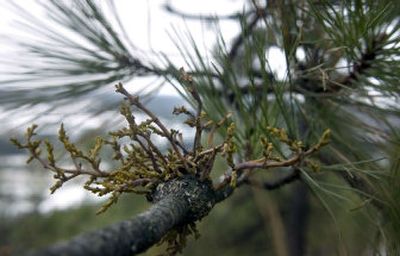Kissing cousin

Stroll with your sweetie into almost any stand of ponderosa pines in the Inland Northwest and – who knows? – maybe you’ll get lucky. You may be standing beneath a sprig of local, native mistletoe.
That’s right, a regional variety of mistletoe, Western dwarf mistletoe, is rampant in our region’s ponderosa pine forests.
“It’s hard to say, but I’d guess it’s on about 30 percent of our pines,” said Jeff Perry, Spokane city arborist.
So, feel free to plant a holiday smooch on your sweetie.
Our native variety is indisputably mistletoe, yet it is hardly the aesthetic equal of the mistletoe we hang over doorways for kissing-facilitation purposes.
That’s usually Eastern mistletoe, which is leafier and greener. Or you might be familiar with European mistletoe, which is even leafier and bigger, and which happens to be one of the most legendary plants in history.
Our Western dwarf mistletoe is a puny cousin. It belongs to the same botanical family, but to a different genus and species, Arceuthobium campylopodum.
It’s also much, much uglier. It looks like a collection of scaly greenish-yellow-brown shoots growing directly out of the bark of a ponderosa pine branch. In the fall it has small berries, but they are not showy like those of the more familiar mistletoes. It also has no real leaves, since it is, essentially, a parasite.
All mistletoes are parasites to some degree, but the Western dwarf mistletoe takes it even further, living almost entirely off of the nutrients from the ponderosa pine. It has the decidedly un-Christmas-like habit of harming its host.
“It disfigures the tree but it usually doesn’t kill it,” said Perry. “Or, at least, not for years.”
Mistletoe lives mostly underneath the tree’s bark, in the cambium layer, sending out only the shoots into the air. The interior portions cause the branch to swell. If the infestation is particularly large, the mistletoe can even force the pine branches to grow in a distorted tangled mess called “witches’ broom.” Look up into almost any stand of pines and you’ll see some of these tangles.
None of this is good for the ponderosa pine. Yet because it doesn’t usually kill the tree, most arborists don’t even try to eradicate it.
“It’s so widespread, you really can’t control it,” said Sally Sullivan, Finch Arboretum gardener.
Timber companies sometimes control it by cutting down infected trees or clearing out entire infected stands. But even that doesn’t guarantee against reinfestation. Mistletoe spreads by explosively shooting a sticky seed out of a pod – the seed can travel more than 30 feet. Where the seed sticks to a branch, a new mistletoe plant takes hold.
“If you miss any, it’ll just come back,” said Perry. “It’s futile. We just work around it.”
Looking at our rather spindly variety, it’s hard to imagine how mistletoe managed to become one of the most powerful mythological symbols of western civilization.
Yet the European mistletoe is thought to be the famous “golden bough” of Virgil’s “Aeneid,” a plant with magical powers which allowed Aeneas to descend into the underworld with confidence. (The bough was “golden” because it had yellow flowers and sometimes yellowish leaves).
In Norse mythology, mistletoe also holds a sacred place. The god Balder could be harmed by nothing “on the earth or under the earth.” However, since mistletoe grew neither on the earth nor under the earth, but on apple and oak trees, Balder was shot dead by a mistletoe arrow.
European mistletoe is equally magical in Celtic and Druid lore, because it remains green throughout the winter, unlike the trees in which it is found. When found on the sacred oak tree, it was considered especially powerful. Mistletoe became a symbol of life, especially in the depths of winter. People would exchange a kiss of peace when they walked under it.
From a symbol of life to a symbol of love and fertility was a small leap. Mistletoe was even thought to have aphrodisiac properties.
The holiday kissing tradition apparently reaches far back to old English custom of “the kissing ball” in which people would hang up a decorated ball of mistletoe in a hall. When couples kissed under it, they would inevitably be married.
Today, mistletoe serves mostly as an invitation to a kiss. Anyone standing under a clump is considered buss-able.
Nobody uses our relatively unimpressive Western dwarf mistletoe for such a purpose. Yet that doesn’t mean they couldn’t. It may be thin, it may be runty, it does not grow on the sacred oak – yet it ought to be good for at least a peck on the cheek.